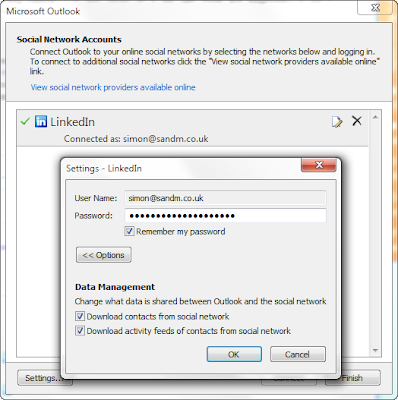Outlook Social Connector beta 2 and the LinkedIn connector

Outlook gets LinkedIn.
Microsoft today rolled out the latest version of the Outlook Social Connector, its Xobni-like tools for exploring the social network in your mailbox. Built around Outlook’s own search tools, the Social Connector adds a new pane to Outlook’s reading view, filling it with links to mails you’ve exchanged with your correspondents, meetings you’ve had and will have had, as well as feeds from external social networks.
This is the second beta of OSC, the first shipping with the Office 2010 beta. The new release adds support for Outlook 2003 and 2007, as well as changing some of the connector’s APIs. Microsoft has been working with social network partners since the release of the first OSC beta, and this release adds functions and features that simplify connecting with external social networks. It’s a quick and easy install, and once you’ve downloaded and installed OSC you can install the first third-party plug-in, from business social network LinkedIn.
 Configuring the LinkedIn OSC plugIn
Configuring the LinkedIn OSC plugIn
OSC connects to social networks using a plug-in architecture, with a fresh plug-in needed for each network. The default SharePoint plug-in is gone in the new release, and instead you can download the much more useful LinkedIn connector that was demonstrated back in November at PDC09. All you need to do is log into LinkedIn, choose your synchronisation options, and you’re immediately able to see status information from connected contacts. The plug-in will also update your contacts, putting contact information in a new LinkedIn contacts folder – including their photograph, so you can recognise someone you’re going to be meeting for the first time. If a contact isn’t connected to you on LinkedIn, then you can use OSC’s green Add icon to initiate a connection. LinkedIn won’t be the only plug-in available, Microsoft also announced that there would be add-ins from Facebook and from MySpace.
 LinkedIn status updates in the OSC pane in Outlook 2007
LinkedIn status updates in the OSC pane in Outlook 2007
There are some idiosyncrasies with the current beta release (after all, it is beta code). Clicking on the green Add button will attempt to add a mail contact to your LinkedIn contacts even if they’re already a contact. We’d have expected it to be aware of an existing relationship – after all, it’s pulling in feeds and address book updates. We also found that the Office 2007 version pulled in LinkedIn status updates multiple times, though only branding them correctly once. We didn’t get the same problem with the Outlook 2010 beta.
Another problem comes if you leap into installing the latest version of OSC on Outlook 2010 beta. The download link on the page Microsoft is advertising sends you straight to another page for the download – skipping past the installation instructions. If you read them, then you’ll find that you have to uninstall the original OSC plug-in before you can upgrade. If you do miss the instructions and install the new OSC release over the old one, you’ll be left with a copy of Outlook that crashes on startup. Use the Change option in the Office 2010 installer to remove OSC.
Once installed and working, OSC turns out to be surprisingly useful, giving you valuable context around your emails. However this is most definitely a version 1 product. It’s buggy (especially on older versions of Outlook) and the information it delivers could be presented more effectively. The result is a set of tools that work well for the casual user, but really don’t have the breadth of the features offered by Xobni. That’s not a bad thing – there’s a lot of information in your inbox that can make your life an awful lot easier, and many more ways of displaying it and using it. With more than one tool out there, competition between the Outlook team and Xobni should result in better tools for mining the data in your inbox.
Simon Bisson